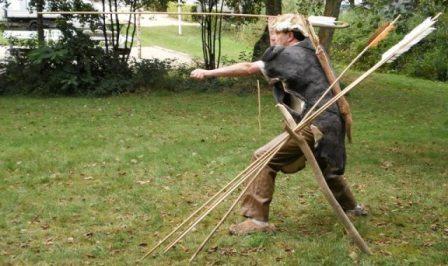A spear is between 130 and 170 cm long and about 11 mm thick. The thicker the spear, the heavier and the more force is needed to throw them. The longer a spear is, the more they will ”flex” or swab in the air, and the greater the possibility that they will break when they hit the ground.
Suitable for wood spears are willow, hazel and ash. Choose straight foothills. Peel them, make them over a fire right and let them (several weeks) to dry. You can easily see whether an arrow is right as you let him toll on his point on your palm.
 A well-balanced arrow or spear actually does not need feathers but for large distances they enhance stability, so they do not fluctuate during the flight.
A well-balanced arrow or spear actually does not need feathers but for large distances they enhance stability, so they do not fluctuate during the flight.
Two, three or four large feathers are the most effective. Flight feathers of wood pigeons, or swans are useful, goose livers best.
Split the pen, scrape them empty and as thin as possible. Leave on top and rearside 1 to 2 cm feather free so they are easy to tie onto the shaft. The feathers are about 4 cm from the ridge of the arrow or the rear end of a spear. Tie and glue the back side, and let them dry.
Pull back the front tight to the point, and also fixate.
(By fixing them oblique or helical you get rotation, that's not necessary.)
Broad feathers provide more stability, narrow feathers will brake the spear less.
Arrow and spearheads can be hardened in the fire. The technique was commonly used for spear or arrowheads. Fire will withdraw moisture and increase the hardness of wood. The tip was polished with a specially selected stone, which also left fine grit in the wood.
By repeating this process emerged a kind of hard fusion of wood, stone and carbon. A heavier point is needed to give arrow or spear the right balance so that the rear end does not arrive first. You can hit or polishing (fire) stones points, or cut one of bone.
Fixed points are put into a cut-out with thread, wet intestine, rough skin or tendon and wood tar. Wet intestines, rope, leather and skin shrink when drying and make them tighten.
On the back a slight dimple in the tip of the spear is made where the hook of the spear thrower comes. (An arrow gets a straight notch to fit the string.)
The spear is probably our oldest weapon.
Hartmut Thieme found in a lignite mine in Schöningen (Germany) 3 spears of about 400,000 years old. A perforated shoulder of a horse (Boxgrove, Sussex) is approximately 500,000 years ago. In Clacton, Essex is a wooden spearhead found of between 420,000 and 360,000 years ago.
Boomerang: wood with homesickness. (Patrick White)
